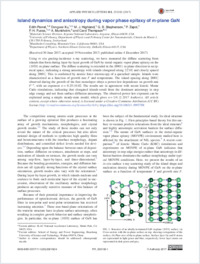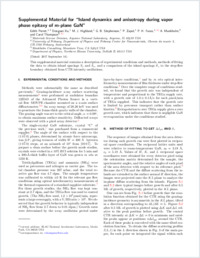Island dynamics and anisotropy during vapor phase epitaxy of m-plane GaN
- Perret, Edith Materials Science Division, Argonne National Laboratory, Argonne, Illinois USA - University of Fribourg, Department of Physics and Fribourg Center for Nanomaterials, Fribourg, Switzerland
- Xu, Dongwei Materials Science Division, Argonne National Laboratory, Argonne, Illinois USA - School of Energy and Power Engineering, Huazhong University of Science and Technology, Wuhan, China
- Highland, M. J. Materials Science Division, Argonne National Laboratory, Argonne, Illinois USA
- Stephenson, G. B. Materials Science Division, Argonne National Laboratory, Argonne, Illinois USA
- Zapol, P. Materials Science Division, Argonne National Laboratory, Argonne, Illinois USA
- Fuoss, P. H. Materials Science Division, Argonne National Laboratory, Argonne, Illinois USA - SLAC National Accelerator Laboratory, Menlo Park, CA USA
- Munkholm, A. Munkholm Consulting, Mountain View, California USA
- Thompson, Carol Department of Physics, Northern Illinois University, DeKalb, Illinois USA
-
04.12.2017
Published in:
- Applied Physics Letters. - 2017, vol. 111, no. 23, p. 232102
English
Using in situ grazing-incidence x-ray scattering, we have measured the diffuse scattering from islands that form during layer-by-layer growth of GaN by metal-organic vapor phase epitaxy on the (101⎯⎯0)(101¯0)(101¯0) m-plane surface. The diffuse scattering is extended in the (0001)(0001)(0001) in-plane direction in reciprocal space, indicating a strong anisotropy with islands elongated along [12⎯⎯10][12¯10] [12¯10] and closely spaced along [0001][0001][0001]. This is confirmed by atomic force microscopy of a quenched sample. Islands were characterized as a function of growth rate F and temperature. The island spacing along [0001][0001][0001] observed during the growth of the first monolayer obeys a power-law dependence on growth rate F−nF−nF−n, with an exponent n=0.25±0.02n=0.25±0.02n=0.25±0.02. The results are in agreement with recent kinetic Monte Carlo simulations, indicating that elongated islands result from the dominant anisotropy in step edge energy and not from surface diffusion anisotropy. The observed power-law exponent can be explained using a simple steady-state model, which gives n = 1/4.
- Faculty
- Faculté des sciences et de médecine
- Department
- Département de Physique
- Language
-
- English
- Classification
- Physics
- License
-
License undefined
- Identifiers
-
- RERO DOC 306776
- DOI 10.1063/1.4993788
- Persistent URL
- https://folia.unifr.ch/unifr/documents/306513
Other files
Statistics
Document views: 91
File downloads:
- pdf: 110
- Supplementary material: 169

